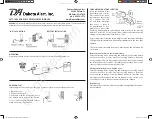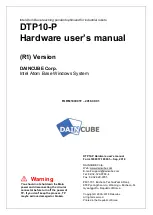
1. Application
The water refilling system is used to automatically maintain
the nominal electrolyte levels.
The charging gasses escape through the vent on each cell.
NO WATERING IN THE FIRST 10 CYCLES.
2. Function
A valve and a float together control the topping up process
and maintain the correct water level in each cell. The valve
allows the flow of water into each cell and the float closes the
valve when the correct water level has been reached.
For fault-free operation of the water refilling system, please
note the instructions below:
2.1 Manual or automatic connection
The battery should be topped up shortly before completion
of a full charge, as at this point the battery has reached a
defined operational state resulting in satisfactory electrolyte
circulation. Filling takes place when the connector (7) from the
tank is connected to the coupling (6) on the battery.
Manual or automatic coupling has to be done in the intervals
according to section 7.
2.2 Filling time
Filling time depends on the utilisation rate and the
corresponding battery temperature. Generally speaking, the
top up process takes a few minutes and can vary according to
the battery range; after this, if manual filling is being used, the
water supply to the battery should be turned off.
2.3 Working pressure
The water refilling system should be installed in such a way
that a water pressure of 0.2 to 0.6 bar is obtained (with at least
2m height difference between the upper edge of the battery
and the lower edge of the tank). Any deviation from this
means that the system will not function properly.
2.4 Purity
The topping up water must be purified. The water used to
refill the batteries must have a conductance of not more
than 30µS/cm. The tank and pipes must be cleaned before
operating the system.
2.5 Pipe system on the battery
The pipe system to the individual battery cells must follow
the battery’s electrical circuit. This reduces the risk of current
leakage in the presence of electrolytic gas causing an
explosion (EN 62485-3). A maximum of 18 cells may be
connected in a series.
The system should not be modified in any way.
2.6 Working temperature
In winter, batteries fitted with Aquamatic should only be
charged or refilled in a room temperature above 0°C.
2.7 Flow control
A flow indicator built into the water supply pipe to the battery
monitors the filling process. During filling the water flow
causes the built-in disc in the flow indicator to turn. When all
the plugs are closed the disc stops, indicating that the filling
process is complete.
7. Water topping up interval
Optional accessories
Water refilling system
1. tank
2. outflow connector with ball valve
3. plug with magnetic valve
4. plug with ball valve
5. flow control
6. coupling
7. connector
8. battery charger
9. charger main switch
1
2
4
5
3
7
6
9
8
PzM variant & Conditions
Water topping up intervals*
1 shift operation
3 shift operation**
4 Weeks PzM/PzMB plus 50Hz
20 Cycles (4 weeks)
20 Cycles (2 weeks)
8 Weeks PzM/PzMB plus HF
40 Cycles (8 weeks)
40 Cycles (5 weeks)
13 Weeks PzM/PzMB plus EC*** & HF
65 Cycles (13 weeks)
65 Cycles (8 weeks)
80% DOD, 5 operating days per week, and average battery temperatures of 20°C
*
+/- 1 week in the most common applications at 20°C
** this number of cycles can be reduced if operating 3 shift and with high battery temperatures!
*** Electrolyte Circulation






















